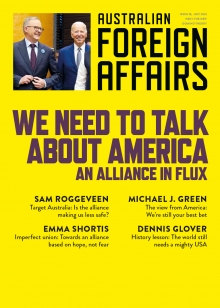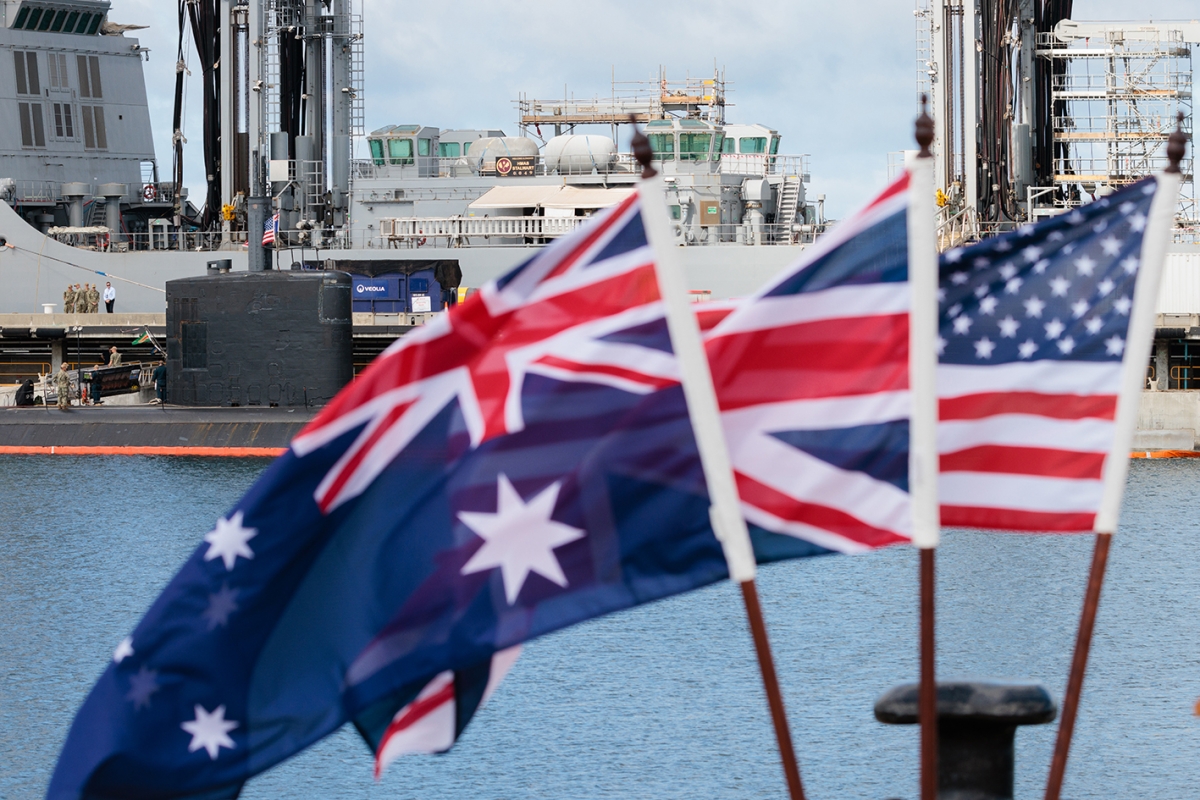
This extract is featured in Australian Foreign Affairs 18: We Need to Talk about America.
To read the full issue, log in, subscribe or buy the issue.
Last October, the ABC’s investigative journalism program Four Corners revealed news that sentripples through Australia’s national debate about defence policy, but ought to have made waves. The revelation, subsequently confirmed by government, was that Australia and the US had agreed toexpand the RAAF Tindal air base, about 300km south of Darwin, so that up to six American strategicbombers could operate from there.
Australia has supported US bomber rotations in the Northern Territory since at least 2006, but, withthis air base refurbishment, the US and Australia are effectively integrating RAAF Tindal into America’s war planning. Australia had previously hosted US bombers for training purposes, but this initiative will allow American bombers to fly operational missions from Australian soil, including in wartime.
If the Tindal decision passed with little comment, the same cannot be said of the March 14 AUKUS announcement in San Diego, California: Australia would acquire three to five second-hand Virginia-class nuclear-powered attack submarines (SSNs) from the US, and then a class of new-generation submarines designed and built with help from the US and the UK, to be known as SSN AUKUS. Prime ministers Anthony Albanese and Rishi Sunak, alongside President Joe Biden, also announced Submarine Rotational Force-West: from as early as 2027, the UK will rotate one SSN through the newly refurbished HMAS Stirling naval base in Western Australia, while the US would contribute four. Australia has also committed to developing a new $10bn east coast base for its nuclear-powered submarines. It too will be capable of supporting US and UK submarines.
Almost all observers agree that these initiatives signal a closer Australian alignment with American foreign policy objectives – they will bring Australia into a tighter American embrace and increase the likelihood that Australia will fight alongside the US should Washington and Beijing go to war, whether over Taiwan or for another reason.
Media coverage in the wake of the Four Corners scoop placed a lot of emphasis on America’sbombers being “nuclear capable”, but that is something of a distraction. US bombers don’t routinely carry nuclear weapons, and certainly not to airfields that aren’t specifically designed to accommodate them. America’s air-launched nuclear weapons are only stored in five countries outside America, all in Europe, at bases built to higher than-normal security standards. If the US ever wanted to store nuclear weapons at RAAF Tindal, such a move would be preceded by long political debate in Australia, and we would observe specific building works and security upgrades at the base. That is not the intention right now.
Yet even without nuclear weapons, US bombers flying out of Tindal could play an important role in the nuclear balance between America and China because they could be tasked with striking China’s nuclear infrastructure, such as missile silos and bases, command and control facilities, early warning radars that let China know of an impending nuclear attack, and air defence facilities designed to keep its nuclear bases safe.
Tindal could not only help the US win a conventional (non-nuclear) war, but also play a part in neutralising China’s nuclear forces. It is clear why American bombers flying out of RAAF Tindal would be an important target for Chinese forces.
Australian submarines and missiles
In February 2023, Prime Minister Albanese boasted that nuclear-powered submarines represent “the single biggest leap in our defence capability in our history”. He’s right. Assuming the submarines are delivered, they will represent a major boost in Australia’s military capabilities because nuclear-powered submarines are so much more effective than the diesel-powered boats we now operate. Nuclear power allows submarines to operate at higher sustained speeds, with infinite range and endurance. The only limits are crew stamina and food supplies. Nuclear boats are also larger, which means they can carry more weapons.
Australia could use its nuclear-powered submarine fleet to defend the continent from military aggression close to our shores. Australia has a huge coastline, after all, so submarines with long endurance and high speed would be useful. But while the government is reluctant to say exactly what it wants the new submarine fleet to do, it seems clear that the intent is not to protect Australia’s coastline directly but to operate thousands of kilometres to our north. Nuclear-powered submarines would be ideally suited to operating off the coast of China, hemming the PLA Navy in home waters. And the requirement for the new submarines to carry Tomahawk cruise missiles canonly be interpreted one way: Australia wants the capability to strike targets on Chinese soil.
In the event of war, what would the AUKUS submarines do when operating near Chinese waters? Their missions would likely be similar to US SSN missions: sinking Chinese naval ships and submarines, blockading ports or striking targets on the Chinese landmass with long-range cruise missiles. One difference, however, is that, owing to the sensitivity of nuclear weapons arsenals, particularly during a war that could easily go nuclear, the US would be unlikely to subordinate nuclear-related missions to Australia’s submarine fleet, such as striking China’s nuclear infrastructure on land or sinking China’s small fleet of ballistic-missile submarines. Still, owing totheir range and endurance, Australian SSNs will be more likely to encounter Chinese ballistic-missile submarines in the course of their operations.
Clearly, having these capabilities raises the likelihood of Chinese military strikes against Australia. But we can go further: they make it more likely that a crisis will escalate into a war, because they incentivise China to launch a pre-emptive surprise attack. In a crisis with the US which is poised onthe brink of conflict, China may feel it is in its interests to strike before Australia’s submarines leave port and before its hypersonic missiles are dispersed to remote locations, simply because it is so much easier to target fixed sites. In turn, this creates an incentive for Australia to pre-empt the pre-emptor. We would be tempted to use our weapons before we lose them.
The political symbolism of Australian strikes against Chinese territory also increases the danger to Australian territory because China would be unlikely to let such a blow by a much smaller power pass without retaliation.
The AUKUS calculation
If a war between the US and China erupted tomorrow and Australia decided to contribute militarily to the US side, it would not be a critical player. We could offer a destroyer and frigate to protect a US aircraft carrier from attacks by submarines, ships and aircraft. The Collins-class submarine fleet could play a role. Aerial refuelling aircraft would be in high demand, and the RAAF could offer up to seven of those. We could hunt Chinese submarines with our P-8 Poseidon maritime patrol aircraft. Perhaps the most potent capability we could offer would be to send a squadron of F-35 fighters toJapan to hit targets in China. But even if Australia did all of these things, given the scale of such awar, they would be niche contributions. By contrast, the combined effect of hosting US bombers and submarines, and having our own nuclear-powered submarines with the ability to hit the Chinese mainland, will substantially raise Australia’s status. Australia will be a bigger target.
Australia takes these risks because we have concluded that, on balance, we are likely to be safer within the alliance, with all the obligations it imposes, than outside it. But if China’s capabilities to strike Australia are set to increase, and if we are raising China’s incentives to do so, then the judgments we have previously made about whether the risks of the alliance outweigh the security benefits need to be re-evaluated. Does the trade-off between the risk of being targeted and the security provided by the alliance still favour Australia? The answer to that question depends on the value Australia places on US military dominance in Asia, including America’s ability to decisively defeat China in a war over Taiwan. If American victory in such a war is a vital interest for Australia, then it is proper for Australia to contribute to sustaining that dominance.
Australia has taken the decision to bring US combat forces, and its military strategy to fight China, onto our shores. We have also chosen to build military capabilities of our own that are designed expressly to contribute to American operations to defeat China. These fateful decisions threaten to draw Australia into a war that is not central to our security interests, and which could end in nuclear catastrophe. Yet America’s reluctance to fully commit to military supremacy over China is a small blessing because it presents an opportunity for Australia to bend American objectives towards a more achievable and stabilising role of balancer rather than leader. That would be a sustainable objective for the US–Australia alliance, and a more justifiable basis on which the US could deploy forces to Australia. But as a military stronghold for a US effort to achieve regional dominance and defeat China in a war over Taiwan, Australia is materially eroding its security for no gain.
This is a 1,493-word extract of a 5,293-word essay in AFA18 – We need to talk about America







